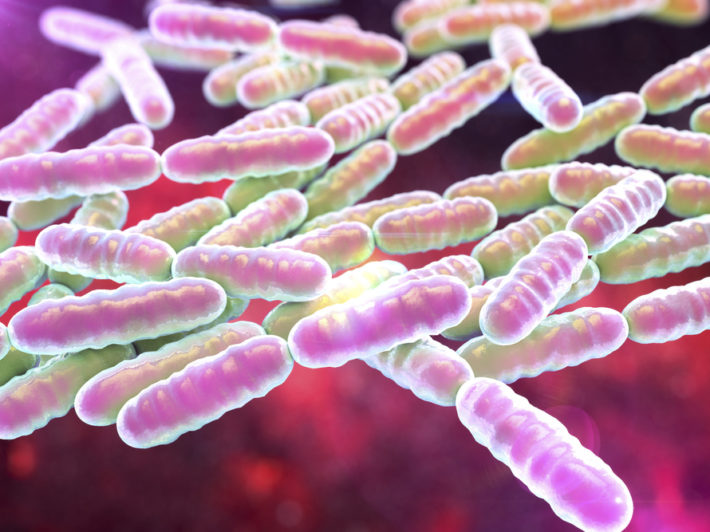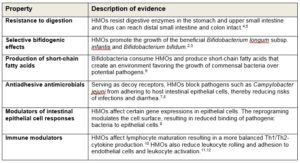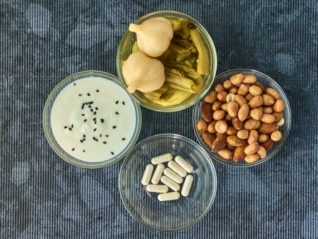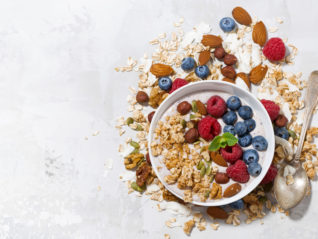
by Lewis Chang, PhD
This multi-part series will help you understand what prebiotics are, what they do, and how they may improve the health of your patients. Based on published scientific literature, this series will also clarify common misconceptions surrounding prebiotics and summarize clinical evidence of specific ingredients with prebiotic properties
Series Part 3: Regarding Human Milk Oligosaccharides (HMOs)
Uniquely human
It was more than 100 years ago when researchers first noticed that breast-fed infants had higher survival rate and better health than bottle-fed infants. Thanks to decades of works and discoveries, we now know that one of the reasons why human milk is unique is because it contains high concentrations of oligosaccharides that are scarcely present in bovine milk (and bovine milk-based infant formula). There are 5-15 g/L of oligosaccharides in human milk but only 0.05 g/L in bovine milk.1
The word oligosaccharide literally means “a few sugars.” Structurally, an oligosaccharide is a sugar polymer consisting of a small number of simple carbohydrates linked together. Human milk oligosaccharides (HMOs) are a mixture of different kinds of oligosaccharides, and they resist digestive enzymes in the stomach.
In the second part of the series (Part 2: Regarding Fiber vs Prebiotics), you may recall that a fiber is also made of many sugar units bonded together and the chemical bonds resist digestive enzymes in the upper gastrointestinal tract. HMOs thus can be described as fibers of human milk.
More than just prebiotics
As described in the first part of the series (Part One: Overview on Prebiotics), a prebiotic (1) resists digestion in the upper gastrointestinal tract, (2) is fermented by the microbiota in the large intestine, and (3) selectively stimulates the growth and/or activity of the gastrointestinal microbiota, thus conferring benefits upon host health. HMOs meet all 3 criteria above. Once ingested, the great majority (~99%) of HMOs can reach colon and provide a growth advantage for beneficial bacteria such as Bifidobacterium longum subsp. infantis and Bifidobacterium bifidum.2,3 That’s why in the early days HMOs were called “bifidus factor.”
However, HMOs also have other important biological functions that go beyond prebiotics. These biological properties are summarized here:
Regarding 2’-fucosyllactose (2’-FL)
More than 100 types of oligosaccharides have been identified in human milk, and the most abundant type is 2’-FL. Researchers have confirmed that 2’-FL alone possesses the biological properties summarized in the table above. That is, 2’-FL functions as a prebiotic utilized by the beneficial bifidobacteria in the gut, prevents pathogenic microorganisms from sticking to host intestinal epithelial cells (which increases the risk of infection and diarrhea), and influences host immune responses.1,13
Because of these demonstrated properties, scientists have been interested in the idea of using 2’-FL (or other isolated oligosaccharides) as a beneficial dietary ingredient for human consumption. Thanks to biotechnologies, 2’-FL can now be produced for commercial use via a fermentation process, and research on 2’-FL has been expanding.
For instance, a recent double-blind, randomized controlled trial demonstrated that consumption of 2’-FL for 2 weeks is sufficient to beneficially modulate the microbiota in adults.14 Another randomized controlled trial found that infants given formula supplemented with 2’-FL exhibited lower levels of inflammatory cytokine profiles, similar to those of breast-fed infants.15
Other health benefits of 2’-FL in humans require additional ongoing research and will take some time, but experimental research using animal models have shown that 2’-FL quenches Campylobacter jejuni-induced inflammation, attenuates the severity of necrotizing enterocolitis, and improves cognitive abilities in both young and adult animals.16-19
To learn more about HMOs, please visit the lectures delivered by the renowned HMOs researcher, Dr. Lars Bode of University of California San Diego:
References
- Bode L. Human milk oligosaccharides: every baby needs a sugar mama. Glycobiology 2012;22:1147-62.
- Asakuma S, Hatakeyama E, Urashima T, et al. Physiology of consumption of human milk oligosaccharides by infant gut-associated bifidobacteria. J Biol Chem 2011;286:34583-92.
- Marcobal A, Barboza M, Sonnenburg ED, et al. Bacteroides in the infant gut consume milk oligosaccharides via mucus-utilization pathways. Cell Host Microbe 2011;10:507-14.
- Chaturvedi P, Warren CD, Buescher CR, Pickering LK, Newburg DS. Survival of human milk oligosaccharides in the intestine of infants. Adv Exp Med Biol 2001;501:315-23.
- Coppa GV, Pierani P, Zampini L, Bruni S, Carloni I, Gabrielli O. Characterization of oligosaccharides in milk and feces of breast-fed infants by high-performance anion-exchange chromatography. Adv Exp Med Biol 2001;501:307-14.
- Gibson GR, Wang X. Regulatory effects of bifidobacteria on the growth of other colonic bacteria. J Appl Bacteriol 1994;77:412-20.
- Ruiz-Palacios GM, Cervantes LE, Ramos P, Chavez-Munguia B, Newburg DS. Campylobacter jejuni binds intestinal H(O) antigen (Fuc alpha 1, 2Gal beta 1, 4GlcNAc), and fucosyloligosaccharides of human milk inhibit its binding and infection. J Biol Chem 2003;278:14112-20.
- Morrow AL, Ruiz-Palacios GM, Altaye M, et al. Human milk oligosaccharides are associated with protection against diarrhea in breast-fed infants. J Pediatr 2004;145:297-303.
- Angeloni S, Ridet JL, Kusy N, et al. Glycoprofiling with micro-arrays of glycoconjugates and lectins. Glycobiology 2005;15:31-41.
- Eiwegger T, Stahl B, Schmitt J, et al. Human milk–derived oligosaccharides and plant-derived oligosaccharides stimulate cytokine production of cord blood T-cells in vitro. Pediatr Res 2004;56:536-40.
- Bode L, Kunz C, Muhly-Reinholz M, Mayer K, Seeger W, Rudloff S. Inhibition of monocyte, lymphocyte, and neutrophil adhesion to endothelial cells by human milk oligosaccharides. Thromb Haemost 2004;92:1402-10.
- Bode L, Rudloff S, Kunz C, Strobel S, Klein N. Human milk oligosaccharides reduce platelet-neutrophil complex formation leading to a decrease in neutrophil beta 2 integrin expression. J Leukoc Biol 2004;76:820-6.
- Castanys-Munoz E, Martin MJ, Prieto PA. 2′-fucosyllactose: an abundant, genetically determined soluble glycan present in human milk. Nutr Rev 2013;71:773-89.
- Elison E, Vigsnaes LK, Rindom Krogsgaard L, et al. Oral supplementation of healthy adults with 2′-O-fucosyllactose and lacto-N-neotetraose is well tolerated and shifts the intestinal microbiota. Br J Nutr 2016;116:1356-68.
- Goehring KC, Marriage BJ, Oliver JS, Wilder JA, Barrett EG, Buck RH. Similar to Those Who Are Breastfed, Infants Fed a Formula Containing 2′-Fucosyllactose Have Lower Inflammatory Cytokines in a Randomized Controlled Trial. J Nutr 2016.
- Yu ZT, Nanthakumar NN, Newburg DS. The Human Milk Oligosaccharide 2′-Fucosyllactose Quenches Campylobacter jejuni-Induced Inflammation in Human Epithelial Cells HEp-2 and HT-29 and in Mouse Intestinal Mucosa. J Nutr 2016;146:1980-90.
- Good M, Sodhi CP, Yamaguchi Y, et al. The human milk oligosaccharide 2′-fucosyllactose attenuates the severity of experimental necrotising enterocolitis by enhancing mesenteric perfusion in the neonatal intestine. Br J Nutr 2016;116:1175-87.
- Oliveros E, Ramirez M, Vazquez E, et al. Oral supplementation of 2′-fucosyllactose during lactation improves memory and learning in rats. J Nutr Biochem 2016;31:20-7.
- Vazquez E, Barranco A, Ramirez M, et al. Dietary 2′-Fucosyllactose Enhances Operant Conditioning and Long-Term Potentiation via Gut-Brain Communication through the Vagus Nerve in Rodents. PLoS One 2016;11:e0166070.






